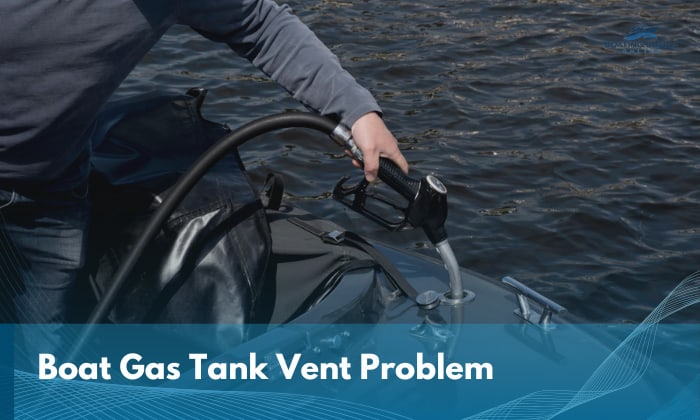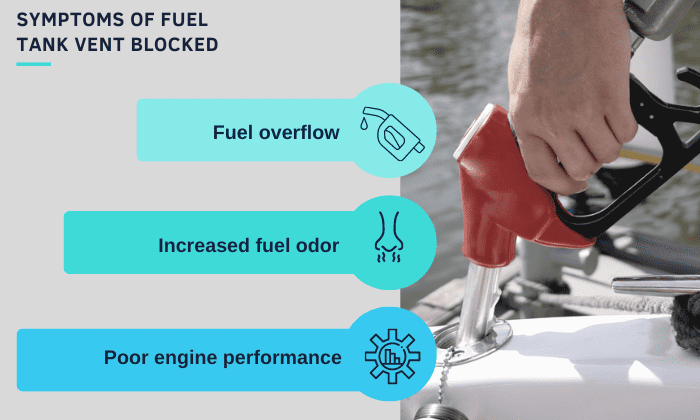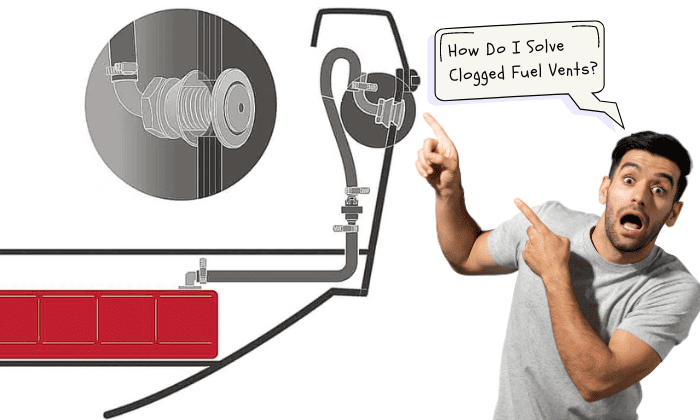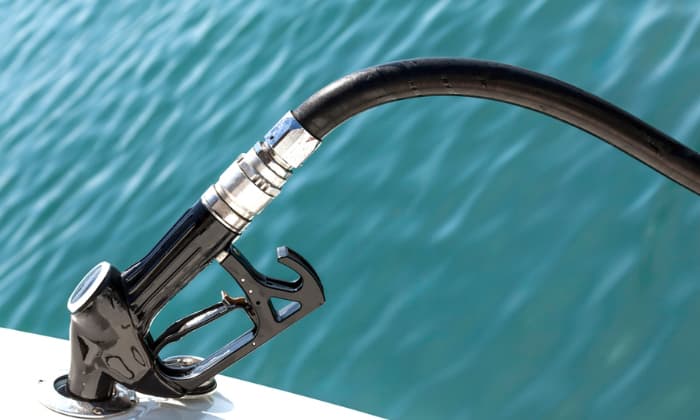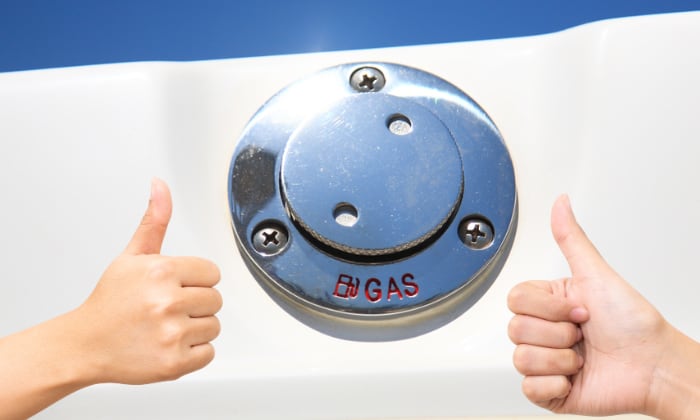When we say “boat gas tank vent problem”, it can mean a slew of various issues that almost always need to be immediately addressed. After all, without a properly working vent, it may not only affect your boat’s performance but pose safety risks to you and your passengers, too.
These gas tank venting problems can be due to a clogged vent hose/vent screen, a setup that prevents optimal airflow, a lack of fuel vent protection, or a consistently wet thru-hull and fuel vent. These pave the way to fuel spillage and difficulty refueling.
Each one has its own cause and solution, so read on to know them all.
Table of Contents
The Common Cause of Most Boat Gas Tank Vent Problems
Considering the nature of marine fuel tank venting, it’s no surprise that one of the most common causes of issues related to it is the blockage of the vent itself. If you look at a standard boat tank vent diagram, there are numerous spots where debris, dirt, and other foreign objects may get stuck.
You have a lot of other possible culprits to deal with, from your standard grime to salt crystals and corrosion. The vent screen itself may gather all that dirt and gunk over the years, thereby crippling the ventilation system.
What are the usual fuel tank vent blocked symptoms? Here they are as follows:
- Fuel overflow – fuel that can’t go forward will inevitably result in backflow. This is why if you’re having a hard time filling your fuel tank lately and you’re noticing leaks, the most likely culprit is a clogged gas tank vent.
- Increased fuel odor – has your nose been noticing a more pronounced gasoline odor lately? This could be due to fuel vapors trapped in your fuel tank.
- Poor engine performance – has your engine been misfiring and stalling more often? It could be because your boat portable gas tank is being deprived of much-needed fuel that can’t get to where it needs to go due to the blockage.
How Do You Solve Clogged Fuel Vents?
The logical step to take is to get rid of what’s causing the blockage in the first place. If sea gunk has built up in the screen and the vent cap underneath it, it can be solved by simply removing it with cleaning tools like wire brushes or an air compressor.
If corrosion has progressed to the point of no return, then you need to replace the screen. If you think it’s still manageable, you can try using a product like PB Blaster to remove the corrosion and keep it from coming back.
Of course, tank vent issues and plastic outboard gas tank problems aren’t limited to just clogging. It could also happen because you installed the vent lines incorrectly and you’re not using appropriate workarounds to prevent the problems in the first place.
I’ve prepared this table to help you identify exactly what you’re dealing with (assuming it’s not a clogging issue), its cause, and how you should solve it.
| Problem | Cause | Solution |
| The nozzle shuts down, and gas leakage makes refueling hard and leads to risks of over-pressurization | Wrong installation of vent line or breather hose, trapping fuel due to the presence of sags | Make sure to pinpoint the correct vent hose location for your setup and there’s no presence of the said sags. If possible, set the hose as straight as you can |
| Water intruding through through-hull fuel vents | Incorrect installation of the vent, particularly if you mount the vent too low on the hull enough for water and ocean spray to enter the vent’s opening | Mount the vent high enough or slightly angled so that it will be protected from oncoming waves and splashes |
| Fuel spewing out when refueling that’s not caused by clogging | Not using a no-spill valve or a fuel-surge protector | Replace the old valve with a universal fuel tank vent valve that prevents spilling or use a fuel surge protector/check valve that’s in-line with the vent to keep the fuel in
Check the no-spill valve periodically to ensure it’s still working. |
| Sprays causing water to mix with the fuel | Waves and torrential rains may hit the fuel vent, to the point that water will enter and pool in the tank with the fuel | Use appropriate coverings such as a clamshell one positioned slightly downward as to deflect the sprays |
Tips to Prevent These Problems in the Future
- Inspect your vent’s screen regularly. I like to always be a step ahead of build-ups, so I clean out anything that gets stuck in them the moment I see them.
- Practice proper fueling techniques. Be mindful of how you filter dust, dirt, and other debris when fueling.
- Make sure you’re installing your vent hose properly.
- Check the entire vent, including the covers, for signs of contaminants, wear and tear, and other damage. Don’t hesitate to avail of maintenance services if you can’t handle any issue you see.
- If you’re wondering whether you need to keep the vent open or closed, the only clues you need are if you’re running the engine or storing your boat.
If it’s running, the vent needs to stay open to ensure that the fuel is flowing unbarred from the tank to the motor. Forgot to open the vent last time? Just try to make it a habit and part of your pre-launch routine.
If you mean to store your vessel, that’s the time to close it to prevent fuel loss and evaporation, which could cause fires and even an explosion.
- Taking your boat out more frequently than usual will prevent the fuel from “going to sleep”, so to speak. Stagnant fuel is never good for a boat, as it almost always means unwanted build-ups.
- Replace fuel tank vent valve the moment you pinpoint that it’s not accepting fuel due to malfunctions. Delaying this will only mean you’re not fueling your tank to its maximum capacity, which may lead to performance issues and more serious problems down the line.
You can do the replacement yourself if you have the time to learn how and apply it.
Frequently Asked Questions
How to properly vent a boat gas tank
Avoiding vacuum blocks, fuel refilling issues, and corrosion is all about the proper installation of the vent line. As such, the vent hose should typically be positioned to run horizontally across the tank’s upper portion and then angle upward towards the fitting on the hull side.
The hose should be routed in such a way that it will follow a straight path to encourage correct fuel drainage.
How do I know if my fuel tank vent valve is bad?
You should start seeing the three main symptoms I’ve outlined above. To jog your memory, the three major signs are fuel overflow, increased fuel odor, and poor engine performance.
Most boaters report that they struggle to fill their tank, so be on the lookout specifically for these symptoms.
What happens if the boat fuel tank is not vented?
It will suffer the same fate as tanks used in rail cars, storage, and retail fertilizer totes. We vent fuel tanks to prevent vacuum areas in the plumbing system, which may cause the tank to collapse and for fuel to spill. The tank needs to be able to “breathe,” in short, and you’re not doing it any favors by deciding to not vent it.
Conclusion
Have you identified your specific boat gas tank vent problem with the help of the facts I’ve shared here? I certainly hope that it’s something benign, such as a mild clogging issue.
If not, it’s not like you don’t have workarounds available to you. To sum up, here are what you should be aware of:
A bunch of sea debris and gunk may cause your vent to clog.
Improper installation of the vent may also lead to issues, so be sure to follow the manufacturer’s recommendations.
Elements outside your control, such as waves splashing and water entering the fuel tank, can be addressed by using the correct protection or simply adjusting how you install certain components.

“My intention from the first day establishing Boating Basics Online is to provide as much help as possible for boaters who want to experience a first safe and convenient trip. So feel free to join us and share your beautiful journeys to the sea!”

